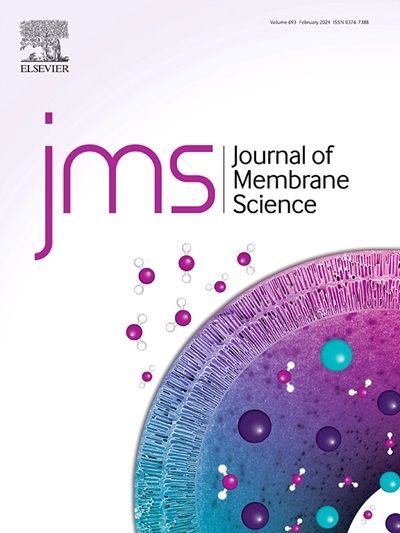Unifying nucleation and crystal growth mechanisms in membrane crystallisation
IF 8.4
1区 工程技术
Q1 ENGINEERING, CHEMICAL
引用次数: 0
Abstract
While several mechanisms have been proposed to describe crystallisation processes in membrane distillation, it has not been possible to provide a definitive description since the nucleation kinetics are difficult to measure. This study therefore introduced non-invasive techniques to measure induction time within two discrete domains (the membrane surface and bulk solution) and was complemented by the introduction of a modified power law relation between supersaturation and induction time, that enables mass and heat transfer processes in the boundary layer to be directly related to classical nucleation theory (CNT). Temperature (T, 45–60 °C) and temperature difference (ΔT, 15–30 °C) were used to adjust boundary layer properties, which established a log-linear relation between the nucleation rate and the supersaturation level in the boundary layer at induction, which is characteristic of CNT. Crystal size distribution analysis demonstrated how nucleation rate and crystal growth rate could be adjusted using ΔT and T respectively. Consequently, ΔT and T can be used collectively to fix the supersaturation set point within the boundary layer to achieve the preferred crystal morphology. However, at higher supersaturation levels, scaling was observed. Discrimination of the primary nucleation mechanisms, using measured induction times, revealed scaling to be formed homogeneously, which indicates exposure of the pores to extremely high supersaturation levels. Morphological analysis of scaling indicated growth to be dominated by secondary nucleation mechanisms, that resulted in a habit that is distinctive from the crystal phase formed in the bulk solution. From this analysis, a critical supersaturation threshold was identified, below which kinetically controlled scaling can be ‘switched-off’, leaving crystals to form solely in the bulk solution comprising the preferred cubic morphology. This study serves to unify understanding on nucleation and growth mechanisms to enhance control over crystallisation in membrane systems.

求助全文
约1分钟内获得全文
求助全文
来源期刊

Journal of Membrane Science
工程技术-高分子科学
CiteScore
17.10
自引率
17.90%
发文量
1031
审稿时长
2.5 months
期刊介绍:
The Journal of Membrane Science is a publication that focuses on membrane systems and is aimed at academic and industrial chemists, chemical engineers, materials scientists, and membranologists. It publishes original research and reviews on various aspects of membrane transport, membrane formation/structure, fouling, module/process design, and processes/applications. The journal primarily focuses on the structure, function, and performance of non-biological membranes but also includes papers that relate to biological membranes. The Journal of Membrane Science publishes Full Text Papers, State-of-the-Art Reviews, Letters to the Editor, and Perspectives.
 求助内容:
求助内容: 应助结果提醒方式:
应助结果提醒方式:


